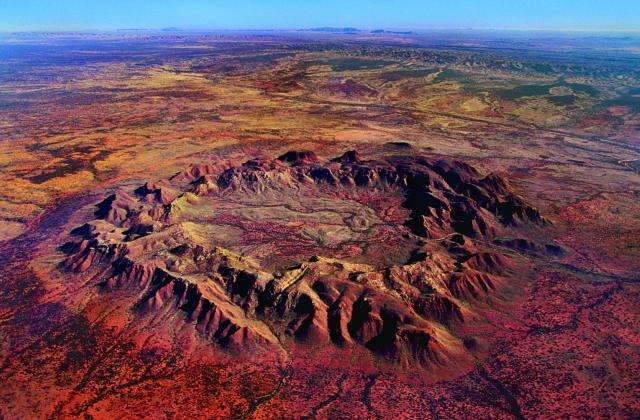(单词翻译:单击)
听力文本
This is Scientific American — 60-Second Science. I'm Julia Rosen.
Other rocky planets in our solar system show a common feature: within giant craters caused by impacts there's evidence of volcanic activity. Which made scientists wonder—can big impacts actually cause volcanic eruptions? And has that scenario ever happened here? To find out, scientists went to one of the few massive craters on Earth not erased by plate tectonics: the Sudbury crater in Canada.
"Sudbury is a 1.85-billion-year-old impact structure."
Teresa Ubide, a geochemist at the University of Queensland in Australia.
"Sudbury was generated when a bolide of 10 to 15 kilometers in diameter hit Earth...and what happened was it obviously generated a large basin and also it melted the...crust on top of the Earth at that time. And generated a massive melt pool, 2.5 kilometers in depth."
But Ubide and her colleagues found that the impact did more than that: it also seems to have triggered eruptions of magma that came from deep in the mantle. The evidence lies in the fact that the chemistry of the lava that erupted at Sudbury changed over time. At first, it matched the surface rocks, suggesting it was just from local melting. But as the eruptions continued, the lava appeared to come from deep in the mantle, suggesting the impact stirred things up inside the Earth.

No one knows yet exactly how the impact could have sparked a prolonged episode of volcanism. One possible explanation is that after the object smashed into the surface, the crust would have rebounded upward, temporarily decompressing the mostly solid mantle and causing it to melt and produce magma. The results are in the Journal of Geophysical Research: Planets.
It's hard to know if the same thing happened on other planets, Ubide says. In many spots in the solar system it looks like volcanism happened much longer after the impact than what she saw at Sudbury. But without material to examine directly, we can't be sure.
Nevertheless, these results do help explain a mysterious chapter in Earth's own history. Most major impacts on our planet happened about four billion years ago, when the solar system was still settling down. But there's no crust around from that time, suggesting the entire planet got a makeover soon after.
"We're suggesting that impacts are able to not only generate the crater, but also, generate melting deeper, say, in the mantle, and bring to the surface material from depth. So actually, recycle and resurface."
It seems the pummeling that Earth endured in the beginning may have triggered volcanic activity that helped wipe away the evidence of those very impacts. In other words, our planet took a beating that may have accelerated its own recovery.
Thanks for listening for Scientific American — 60-Second Science Science. I'm Julia Rosen.
参考译文
这里是科学美国人——60秒科学。我是朱莉娅·罗森。
我们太阳系中其他岩质行星拥有一个共同特征:由撞击形成的巨大陨石坑中有火山活动的迹象。这使科学家想知道,巨大的撞击真能引起火山喷发吗?地球上发生过这种情况吗?为了找到答案,科学家前往地球上未被板块构造运动消除的几个大型陨石坑之一——加拿大的萨德伯里陨石坑。
“萨德伯里陨石坑的冲击构造拥有18.5亿年的历史。”
特里萨·乌维德是澳大利亚昆士兰大学的地球化学家。
“萨德伯里是由一个直径为10到15千米的火流星撞击地球而形成的,很明显,撞击形成了一个巨大的盆地,同时也熔化了当时地球的外层地壳。而且还形成了一个2.5千米深的巨大熔池。”
但是乌维德和她的同事发现撞击的影响不止如此:它似乎还引发了地幔深处的岩浆喷发。证据在于,萨德伯里喷发的岩浆,其化学成分随着时间推移而发生变化。一开始,岩浆的化学成分与地球岩石相吻合,这表明岩浆来自局部熔融。但随着喷发的持续,岩浆似乎来自地幔深处,这表明撞击搅动了地球的内部物质。
目前没有人确切知道撞击是如何引发长期火山活动的。一种可能的解释是,陨石撞入地表以后,地壳会向上回弹,暂时为基本上是固态的地幔减压,使其熔化并产生岩浆。这项研究结果发表在《地球物理研究:行星》期刊上。
乌维德表示,很难知晓其他星球是否也发生过同样的事情。太阳系中的许多地方都有火山活动,看起来发生时间比她在萨德伯里看到的撞击时间要晚得多。但是没有可供直接查验的材料,我们无法确定。
尽管如此,这些结果依然有助于解释地球历史中的神秘章节。地球上大多数巨大的撞击主要发生在约40亿年前,那时太阳系还在形成中。不过当时地球还没有地壳,这表明整个星球在不久之后发生了大转变。
“我们认为,撞击不仅能产生陨石坑,还能让地幔深处的物质熔化,并将其带到地球。整个过程会再循环,深层物质浮出水面。”
看起来,地球早期遭受的撞击可能引发了火山活动,而火山活动擦掉了撞击留下的证据。换言之,我们的星球遭受了可加速自身复原的撞击。
谢谢大家收听科学美国人——60秒科学。我是朱莉娅·罗森。
译文为可可英语翻译,未经授权请勿转载!
重点讲解
重点讲解:
1. at first 最初;起初;开始时;
例句:At first I didn't know what to make of it.
起初我搞不清那是怎么回事。
2. stir up 扬起(灰尘);卷起(泥浆);
例句:They saw first a cloud of dust and then the car that was stirring it up.
他们先看到了扬起的一团尘土,然后才看到了汽车。
3. settle down (历经磨难或变化后)安静下来,平静下来;
例句:It'd be fun, after the situation in Europe settles down, to take a trip over to France.
等欧洲的局势平定下来后,去法国旅行一趟应该不错。
4. wipe away 擦去;擦掉;揩干;
例句:He wiped away the blood with a paper napkin.
他用纸巾将血迹擦去。


